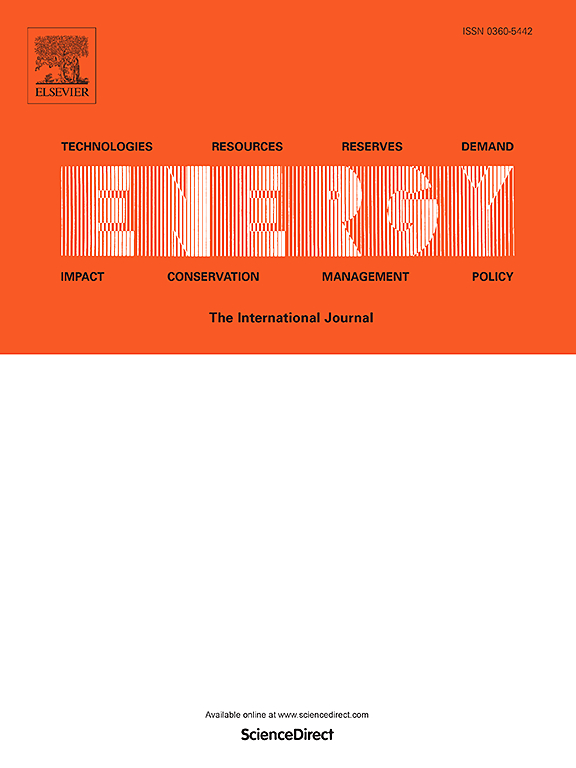A novel hybrid ensemble approach for wind speed forecasting with dual-stage decomposition strategy using optimized GRU and transformer models
IF 9
1区 工程技术
Q1 ENERGY & FUELS
引用次数: 0
Abstract
Wind energy has attracted global interest owing to its sustainable and environmentally friendly characteristics. Nevertheless, precisely forecasting wind speed can be challenging due to its volatile and unpredictable nature. This paper presents a new hybrid forecasting approach based on dual stage decomposition mechanism, namely TMQGDT for wind speed prediction. At first, a decomposition technique called time-varying filtered based empirical mode decomposition (TVFEMD) is utilized to decompose the original wind speed data into several intrinsic mode functions (IMFs). Afterwards, multi-scale permutation entropy (MPE) is used to assess the complexity of each IMF. Based on the entropy values, the IMFs are further classified into high-frequency and low-frequency IMFs. To address the significant volatility observed in the high-frequency IMFs, discrete wavelet transform (DWT) method is employed to perform secondary decomposition. The low-frequency IMFs are forecasted using gated recurrent unit (GRU) model optimized with quantum particle swarm optimization (QPSO) algorithm, while the high-frequency IMFs are forecasted with the Transformer model. The proposed model is trained and validated using four wind speed time series datasets collected from Germany and China. Five individual models and six hybrid models are compared against the proposed model to validate the forecasting performance of the proposed TMQGDT model. The prediction outcomes reveals that the R2 of the model is 0.973, 0.968, 0.956, and 0.996 on the four dataset test sets, which has improved by 3.39 %, 3.93 %, 5.53 %, and 0.50 %, respectively, compared to the TVFEMD-MPE-QPSO-GRU-DWT-Autoformer model. The excellent accuracy performance of the TMQGDT model indicates that developing a hybrid model based on deep learning techniques using secondary decomposition mechanism and optimization algorithm can enhance the precision of wind speed prediction.
基于优化GRU和变压器模型的风速双阶段分解混合集合预报方法
风能因其可持续和环境友好的特点而吸引了全球的兴趣。然而,由于其不稳定和不可预测的性质,精确预测风速是具有挑战性的。本文提出了一种基于双阶段分解机制的混合风速预报方法——TMQGDT。首先,利用时变滤波经验模态分解技术(TVFEMD)将原始风速数据分解为若干个内禀模态函数(imf)。然后,利用多尺度排列熵(MPE)来评估每个IMF的复杂性。根据熵值进一步将其分为高频和低频两类。为了解决高频imf中观察到的显著波动,采用离散小波变换(DWT)方法进行二次分解。采用量子粒子群优化(QPSO)算法优化的门控循环单元(GRU)模型预测低频IMFs,采用Transformer模型预测高频IMFs。利用德国和中国的4个风速时间序列数据集对该模型进行了训练和验证。将5个单独模型和6个混合模型与所提出的模型进行比较,验证了所提出的TMQGDT模型的预测性能。预测结果表明,该模型在4个数据集上的R2分别为0.973、0.968、0.956和0.996,分别比TVFEMD-MPE-QPSO-GRU-DWT-Autoformer模型提高了3.39%、3.93%、5.53%和0.50%。TMQGDT模型良好的精度性能表明,利用二次分解机制和优化算法开发基于深度学习技术的混合模型可以提高风速预测的精度。
本文章由计算机程序翻译,如有差异,请以英文原文为准。
求助全文
约1分钟内获得全文
求助全文
来源期刊

Energy
工程技术-能源与燃料
CiteScore
15.30
自引率
14.40%
发文量
0
审稿时长
14.2 weeks
期刊介绍:
Energy is a multidisciplinary, international journal that publishes research and analysis in the field of energy engineering. Our aim is to become a leading peer-reviewed platform and a trusted source of information for energy-related topics.
The journal covers a range of areas including mechanical engineering, thermal sciences, and energy analysis. We are particularly interested in research on energy modelling, prediction, integrated energy systems, planning, and management.
Additionally, we welcome papers on energy conservation, efficiency, biomass and bioenergy, renewable energy, electricity supply and demand, energy storage, buildings, and economic and policy issues. These topics should align with our broader multidisciplinary focus.
 求助内容:
求助内容: 应助结果提醒方式:
应助结果提醒方式:


